How to Play Speed
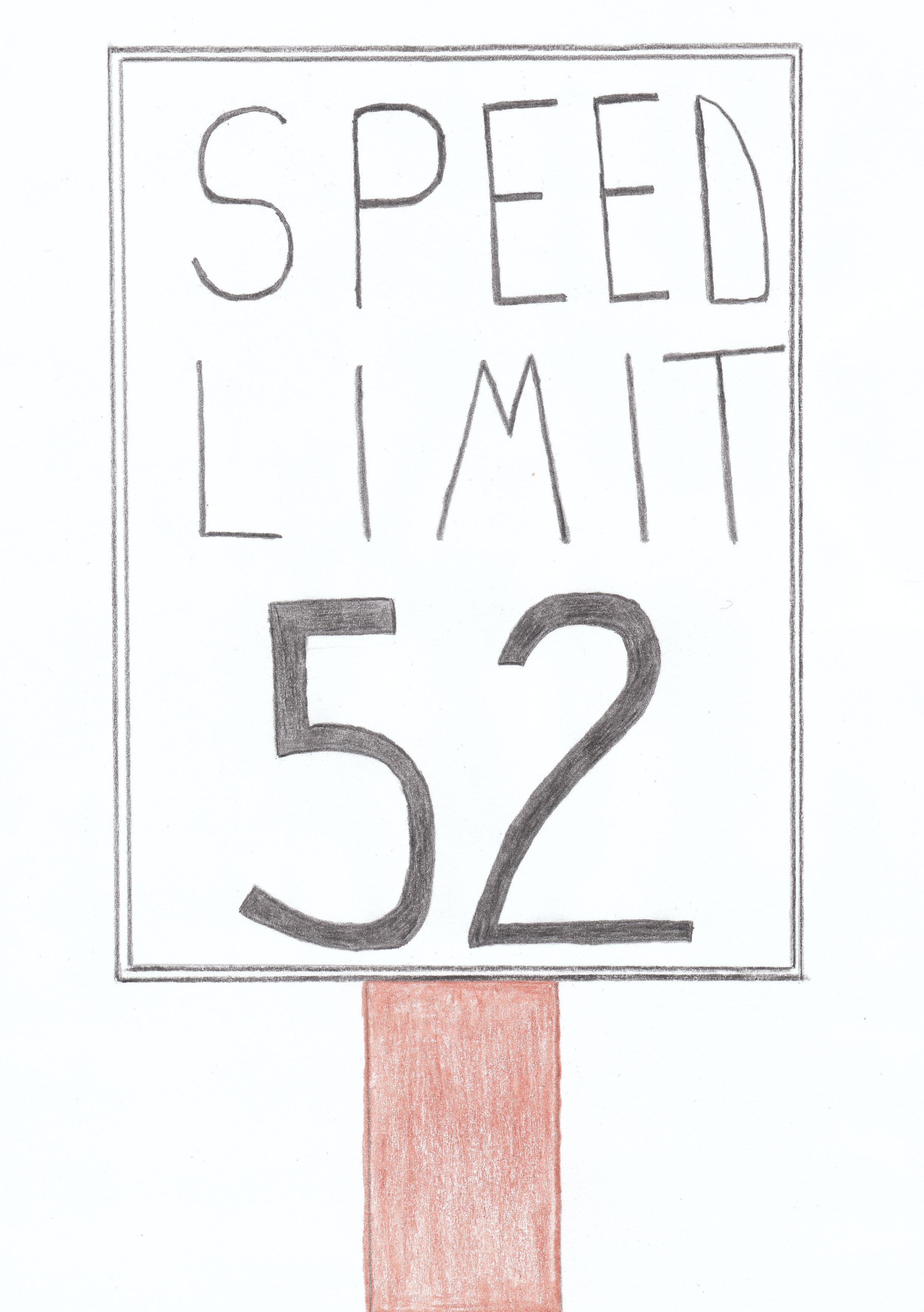
Speed is a very exciting and fast moving game designed for two players. There are a number of varieties of this game which are played, however one of the most popular versions is described first. Several alternate versions are described in the Variations and optional rules section, below.
This game can get rather chaotic, with no individual "turns", as players
will play cards as able. Thus, the dealer of each game is largely
irrelevant as pertains to first play, etc. However, if there is any
disagreement regarding who should deal first, both players can draw one
card from the face down, shuffled deck. The player drawing the lowest
card deals first. If both players draw a card of the same denomination,
they draw again, continuing to do so until they do not draw cards of
equal rank. Thereafter, the privilege to deal alternates back and forth between the two players.
Although usually played by two players, it can be modified slightly to allow for additional players (see variations section below).
The suits and ranks have no comparative values, however, for play of the game cards are played such that a card must fit next in sequence (either ascending or descending). The sequence of the cards for this game, is as follows: Ace, 2, 3, 4, 5, 6, 7, 8, 9, 10, Jack, Queen, King. The Ace is considered to both come before two and after King so the sequence can continue indefinitely and in any direction at any time (more about this below).
To begin, the dealer will deal a special layout. He first deals two face down piles of 5 cards each to the center of the table. These are called replacement piles. Then, the dealer deals the remainder of the deck into two face-down piles, one for each player. In doing this, the dealer deals the cards alternating between the two players, starting with his opponent. Each player should end up with 21 face down cards dealt to them. They should not yet look at any of the cards.
At this point each player should then draw five cards from the top of their own pile which will be their initial hands, but the player should not yet look at these cards until the game begins. The layout is now ready to begin the game. The following diagram shows how this initial layout might appear.
Play of the Hand: Each player then takes the top card of one of the replacement piles and instantly and simultaneously flips it over on the table next to the pile. These are the play piles. They then immediately pick up their hand of five cards and may begin playing cards to these play piles.
The players may then play cards from their hand to either of the two play piles. A card may be played as long as it falls in sequence, either up or down, based on the card currently there. Thus an eight could be played on a 7 or a 9. The card need not match the suit of the top card of the piles. Either player can make a play at any time and may play any allowable card as long as it falls one rank either up or down in sequence to the current top face-up card on the pile. There are no actual turns, with both players playing simultaneously to the play piles as their hand allows.
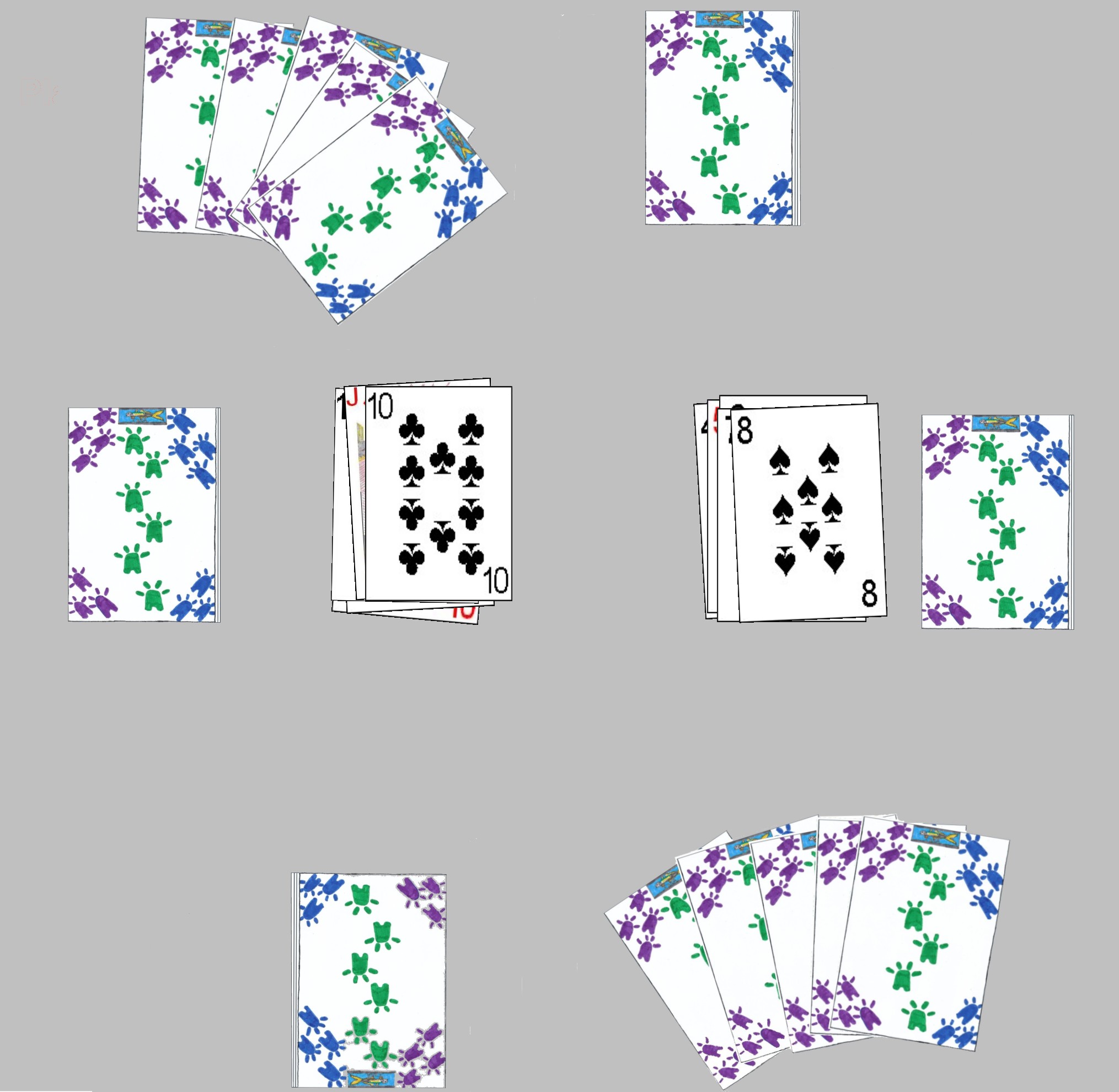
If both players attempt to play a legal card to the pile, the card first played (even if only by a fraction of a second) is considered the legal play and the other player must take his card back into his hand to play later. For purposes of the game King and Ace are considered to be in sequence, thus an Ace can be played on a King and a King on an Ace. The card played can be of any suit, as long as it falls into sequence with the current card on the pile. A player is allowed to have five cards in his hand at all times, thus whenever he finds himself with less he may draw cards from his stack to replenish his hand to five cards. Of course, if his stack is empty, he may find himself playing with four or less cards.
If it comes about that both players, still having cards in their hand are unable to make a play to either of the two play piles, they both should announce this. When this happens, the players then take the next face down card from each of the replacement piles, as described above. They both would then again begin playing as legal plays are found. The illustration to the right shows a possible game of speed in progress.
If the replacement piles become exhausted and both players are unable (or prefer not) to make a legal move they would then turn the used play piles over and shuffle them to make two new face-down replacement piles. Both players would then simultaneously flip over the top card from these piles to start the play piles over. The game would then continue as normal.
The first player to play the last of his cards is declared the winner (all the cards from his hand and those from his individual pile). Although each hand can be considered a complete game, speed is usually played with the first player to win two out of three games considered the winner.
Four Card Hands: This version is played identically to the standard game other than the number of cards a player may have in his hand while playing. Instead of dealing himself a five card hand before starting, the players would each deal themselves only four card hands. Throughout the game, the player may only have a maximum of four cards in their hand at any time. This makes the game more challenging as the players have less cards with which to find legal plays.
Jokers: This variation is also played identically to standard Speed, with the only exception being the addition of two Jokers to the deck. These Jokers are then wild cards and essentially can be played as any card the player wants. A player can play a joker on any card that is on a play pile and when a Joker is the top card of a play pile (either played there or flipped from a replacement pile) any card can be played on that joker. If Jokers are added, each player would receive 22 face-down cards at the beginning of the hand instead of the usual 21.
 Doubles
Doubles: Another variation which is very similar to the standard game is the "Doubles" rules. The game is played the same as the standard game with one important exception. In addition to being able to play a card that follows in ascending or descending sequence, a player may also play a card that is of the same rank. Thus, a 9 could be played on another 9 as well as on any 8 or 10.
Speed for additional players: Speed can also be played with more than two players. When doing so, however, the number of cards dealt to the various piles is somewhat different:
- For three players, each player should receive a face-down pile of 16 cards and three cards should be placed face up on the table (rather than having the standard replacement piles). There will be one card left the deck which should be set aside and will not take part in this hand. Each players hand should consist of a maximum of four cards at any one time.
- For four players, each player would receive face-down piles of 12 cards. Two replacement piles containing two cards each are used. The maximum cards a player should have in his hand at any one time during the game is four.
- Another alternative for four players is to use two standard decks shuffled together, instead of one. In this case, each player would receive 24 cards. Four replacement piles would be dealt to the center with two face-down cards per pile. At the beginning of the game or when all players are unable to make further plays (but still have cards in their hand), each player would flip over the card from the replacement pile closest to their seat. A player should have a maximum of four cards in his hand at any one time during the game.
- Speed can be played by even more players, however it can get quite chaotic with everyone playing simultaneously, thus it is usually limited to 4. However, if a group of 5 people want to play this game, they should ensure the players cards are dealt such that each player gets an equal number of cards. Usually a player is entitled to have a maximum of four cards in his hand at any one time and there are usually four play piles used. Each of the these play piles usually has a minimum of spare cards (2 or 3). Often when played by 5 or more such players, two or more decks are shuffled together to allow each player to have a fairly large number of cards they need to play in order to win the hand.
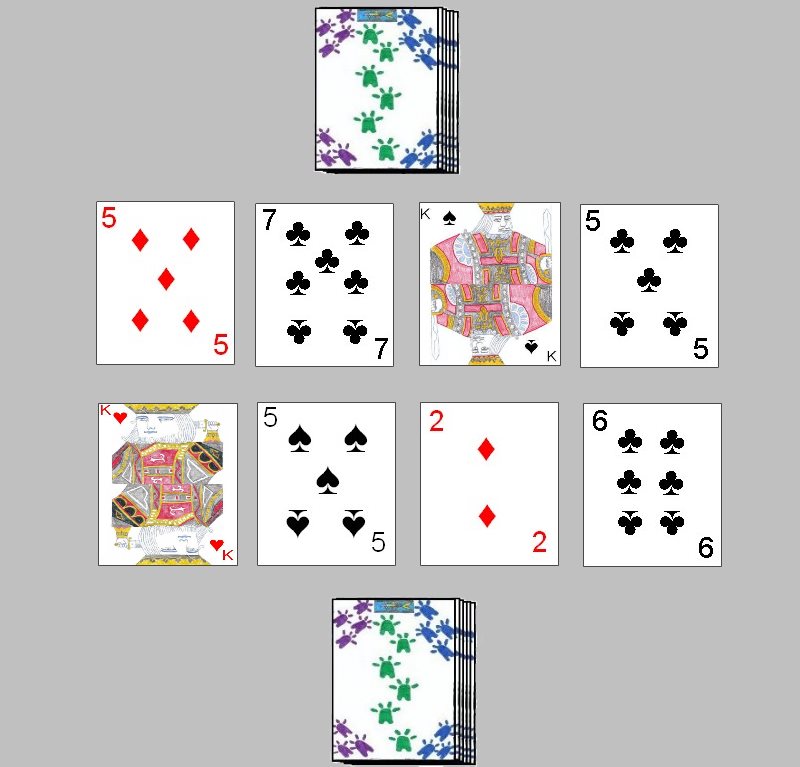 California Speed
California Speed: California Speed is another fast-moving game for two players in which there are no actual turns, with both players playing the hand simultaneously. Although bearing some resemblance to standard Speed, it also is significantly different from that game. Despite the name, this game is played throughout the United States
and other parts of the world as well, not just in the state of California. It goes by a number of different names, such as Super Spit, Spit 2, California Spit, Rush, and Spit 3.
The game uses one standard 52 card deck which is dealt out evenly into two face-down pile, one for each player. Each player should thus have a stack of 26 cards. During the game each player never actually looks at his cards, but rather plays cards, directly from the top of his stack
to the center of the table as able. Each player often holds his stack in one hand and uses the other to play cards to the central layout which will be formed once the game begins.
Once each player has his stack aligned in front of himself the dealer gives a signal and the round begins. To start each round, both players deal four face-up cards from his tack in a row to the table. Thus, the layout will consist of eight total face-up cards
(one row placed by each player). The object of each player is then to
deplete his stack by playing cards from the stack to the eight card
piles on the table. If there are two or more cards exposed on the center layout which are of the exact same rank, these cards are open for play
(the suit of the cards do not matter, all that is important is that the
cards are of the exact same rank, i.e. 3 fives or 2 Kings). In other words a player may play the top card from his stack face-up and directly on top of this card, covering that card with the card from his stack. Players do not take turns and
simply play as able, attempting to cover cards as fast as possible in an effort to play the most cards from his stack in this way. If both players attempt to play a card on top of the same card, the card which was placed first has precedence and the other player has to return his own card to the top of his pile.
If, when playing a card, his card played is also of the same rank as the
card it is placed on (called a double), he may play another card on top
of that same pile.
The game continues in this way until there are no more plays available
on the center layout. At this time, each player then takes the cards
forming the four piles closest to himself and adds them to the bottom of
his stack to complete the round. The next round is played similarly to
the first, with the dealer giving a signal and the players each placing
four face-up cards in a row in front on the table and then a frantic
effort to cover any cards of matching rank with the top card from his
face-down pile..
The game continues this way in a series of rounds until one player manages to play the last of his card to the center layout, with the player declared the winner of the game.
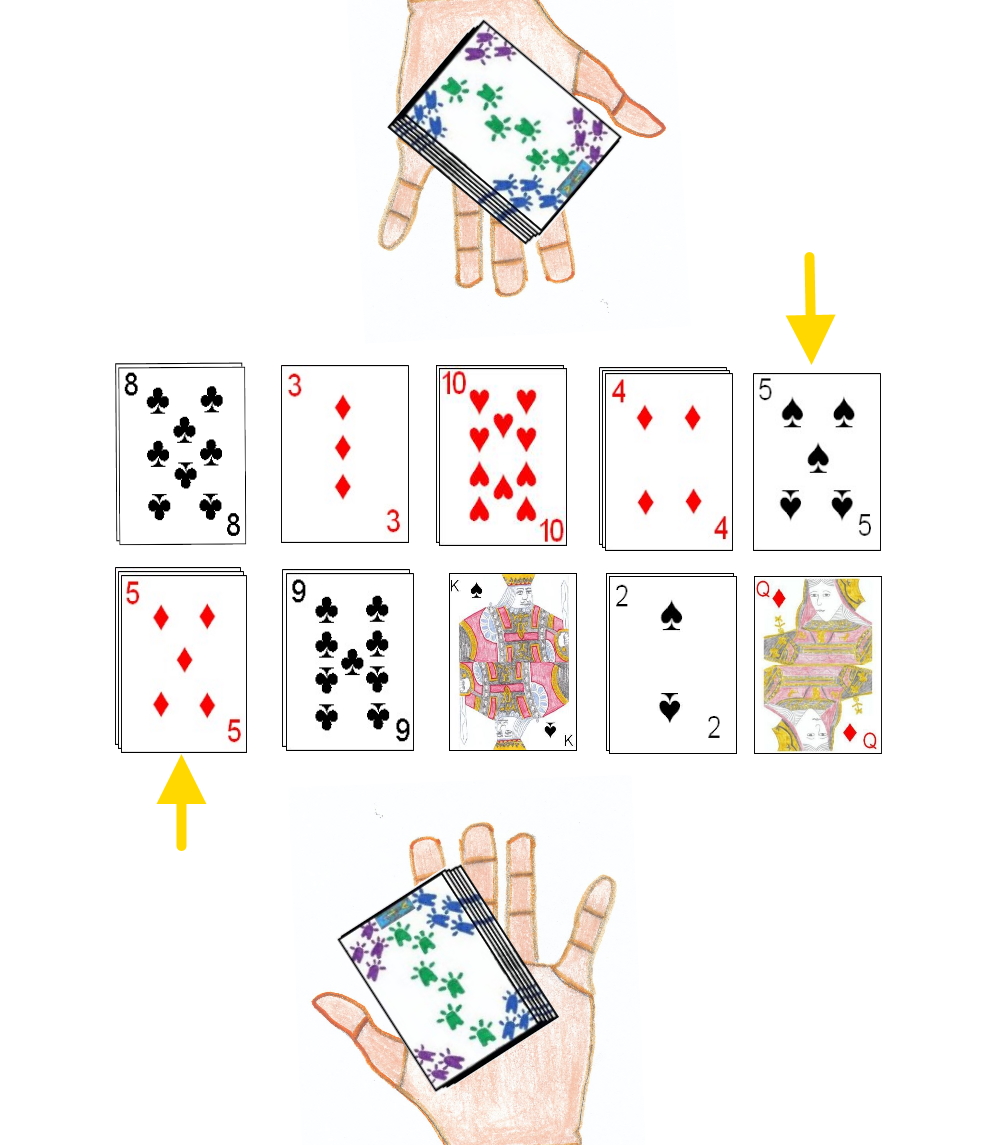 Aggravation
Aggravation: Aggravation is another game which relies on quick thinking and fast reflexes. It appears to be a variant of California Speed. Similar to Speed, Aggravation is designed for play by two players, using one standard 52 card deck. The ranking of the cards in the deck are the same as in Speed and most of it's variations.
After the deck is shuffled and cut, the designated first dealer should then deal the cards such that each player has a stack of 26 cards directly in front of him. The players should not, however, look at these cards, but simply hold this stack of cards in one hand during the course of play.
At a signal by the dealer (such as a count to three), both players immediately and simultaneously turns over the top card from his stack and places that card face-up in front of him on the table, somewhat to the left. The cards should be played such that they are played directly across from the card played by the opponent,
and at the same time. Then, at another signal, both players then play another card from the stack, face-up to the table. This card should then be played to the immediate right of the last card played, forming a horizontal row in front of the player, and again should be played simultaneously with the opponent and directly opposite that card on the table. The game continues in this manner, with the dealer giving a signal and each player playing his card on his ever-increasing row of cards (the tableau).
If at any time during play, a player notices two cards of the exact same rank, he will immediately play the top card from his pile onto each of the matching cards. As in other games of this type, the first player to get his card onto the spot is entitled
to make that play. If these cards create other matches on the table, each player will continue attempt to
quickly (before the opponent) place the next card from his pile to cover these matching cards. Once no more matching cards are found on the tableau, the game resumes again with the dealer announcing the deal of another card by both players to the table.
Once a player's deck is reduced to just one card remaining in his stack,
he does not play it during the usual announcement, and only the player
who has more than one card continues to add cards to the tableau.
However, a player with only one card may immediately play it on a match
if such is discovered in the tableau during continued play. Once a
player plays this last card, however, he still has not yet won the game.
The next time a match is created on the tableau, the player must touch,
with his two index fingers, the two cards forming the match and yells
"Aggravation" thus winning the game. If both players are so reduced to
only one card remaining, they both play this card at the same time, and
the first player to touch the two cards that match and shout "Aggravation" is the winner.
Copyright © 2015 CatsAtCards.com. All rights reserved.
 Speed is a very exciting and fast moving game designed for two players. There are a number of varieties of this game which are played, however one of the most popular versions is described first. Several alternate versions are described in the Variations and optional rules section, below.
Speed is a very exciting and fast moving game designed for two players. There are a number of varieties of this game which are played, however one of the most popular versions is described first. Several alternate versions are described in the Variations and optional rules section, below.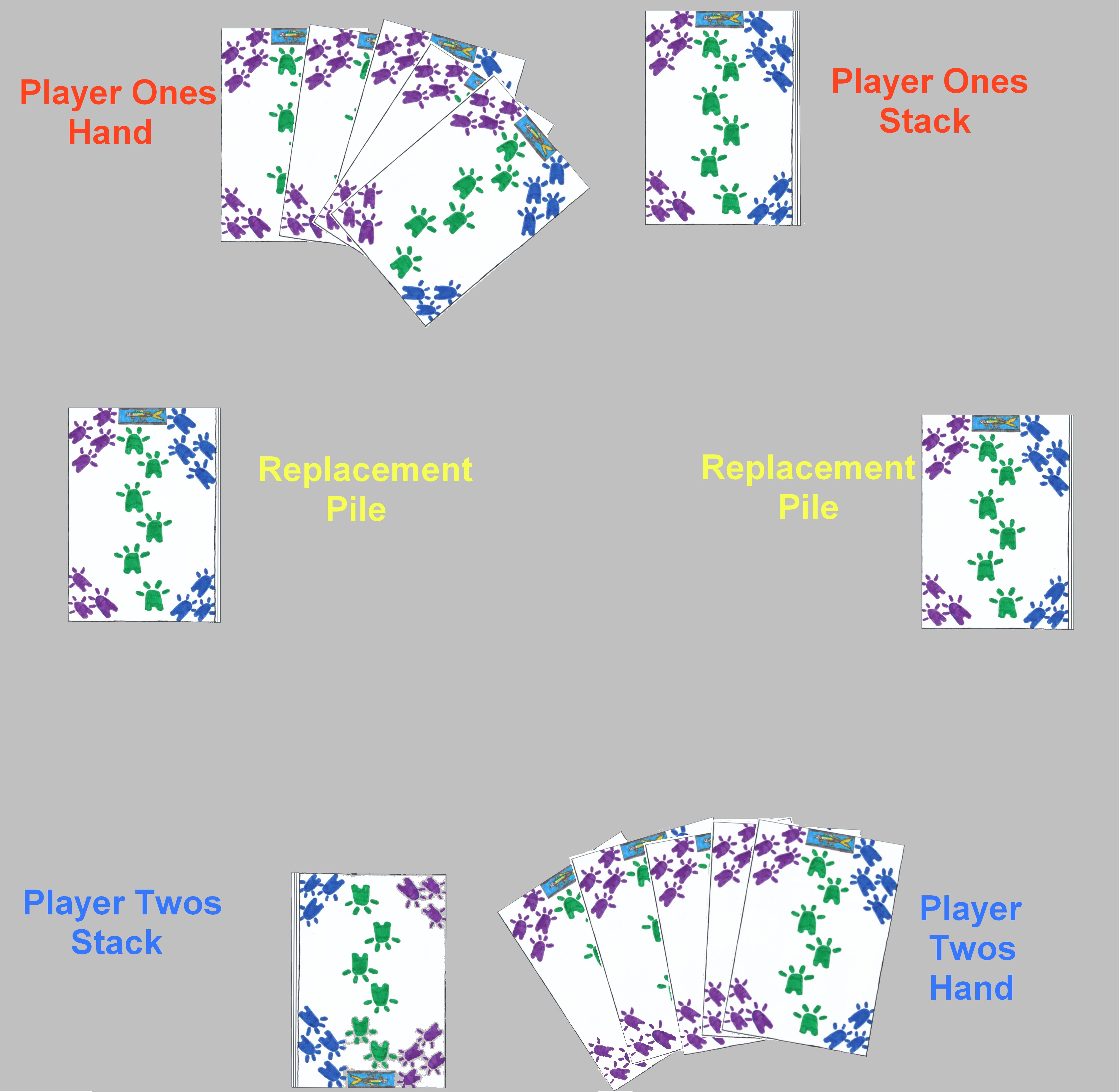
 If both players attempt to play a legal card to the pile, the card first played (even if only by a fraction of a second) is considered the legal play and the other player must take his card back into his hand to play later. For purposes of the game King and Ace are considered to be in sequence, thus an Ace can be played on a King and a King on an Ace. The card played can be of any suit, as long as it falls into sequence with the current card on the pile. A player is allowed to have five cards in his hand at all times, thus whenever he finds himself with less he may draw cards from his stack to replenish his hand to five cards. Of course, if his stack is empty, he may find himself playing with four or less cards.
If it comes about that both players, still having cards in their hand are unable to make a play to either of the two play piles, they both should announce this. When this happens, the players then take the next face down card from each of the replacement piles, as described above. They both would then again begin playing as legal plays are found. The illustration to the right shows a possible game of speed in progress.
If both players attempt to play a legal card to the pile, the card first played (even if only by a fraction of a second) is considered the legal play and the other player must take his card back into his hand to play later. For purposes of the game King and Ace are considered to be in sequence, thus an Ace can be played on a King and a King on an Ace. The card played can be of any suit, as long as it falls into sequence with the current card on the pile. A player is allowed to have five cards in his hand at all times, thus whenever he finds himself with less he may draw cards from his stack to replenish his hand to five cards. Of course, if his stack is empty, he may find himself playing with four or less cards.
If it comes about that both players, still having cards in their hand are unable to make a play to either of the two play piles, they both should announce this. When this happens, the players then take the next face down card from each of the replacement piles, as described above. They both would then again begin playing as legal plays are found. The illustration to the right shows a possible game of speed in progress.
 Doubles: Another variation which is very similar to the standard game is the "Doubles" rules. The game is played the same as the standard game with one important exception. In addition to being able to play a card that follows in ascending or descending sequence, a player may also play a card that is of the same rank. Thus, a 9 could be played on another 9 as well as on any 8 or 10.
Doubles: Another variation which is very similar to the standard game is the "Doubles" rules. The game is played the same as the standard game with one important exception. In addition to being able to play a card that follows in ascending or descending sequence, a player may also play a card that is of the same rank. Thus, a 9 could be played on another 9 as well as on any 8 or 10. California Speed: California Speed is another fast-moving game for two players in which there are no actual turns, with both players playing the hand simultaneously. Although bearing some resemblance to standard Speed, it also is significantly different from that game. Despite the name, this game is played throughout the United States
and other parts of the world as well, not just in the state of California. It goes by a number of different names, such as Super Spit, Spit 2, California Spit, Rush, and Spit 3.
California Speed: California Speed is another fast-moving game for two players in which there are no actual turns, with both players playing the hand simultaneously. Although bearing some resemblance to standard Speed, it also is significantly different from that game. Despite the name, this game is played throughout the United States
and other parts of the world as well, not just in the state of California. It goes by a number of different names, such as Super Spit, Spit 2, California Spit, Rush, and Spit 3.
